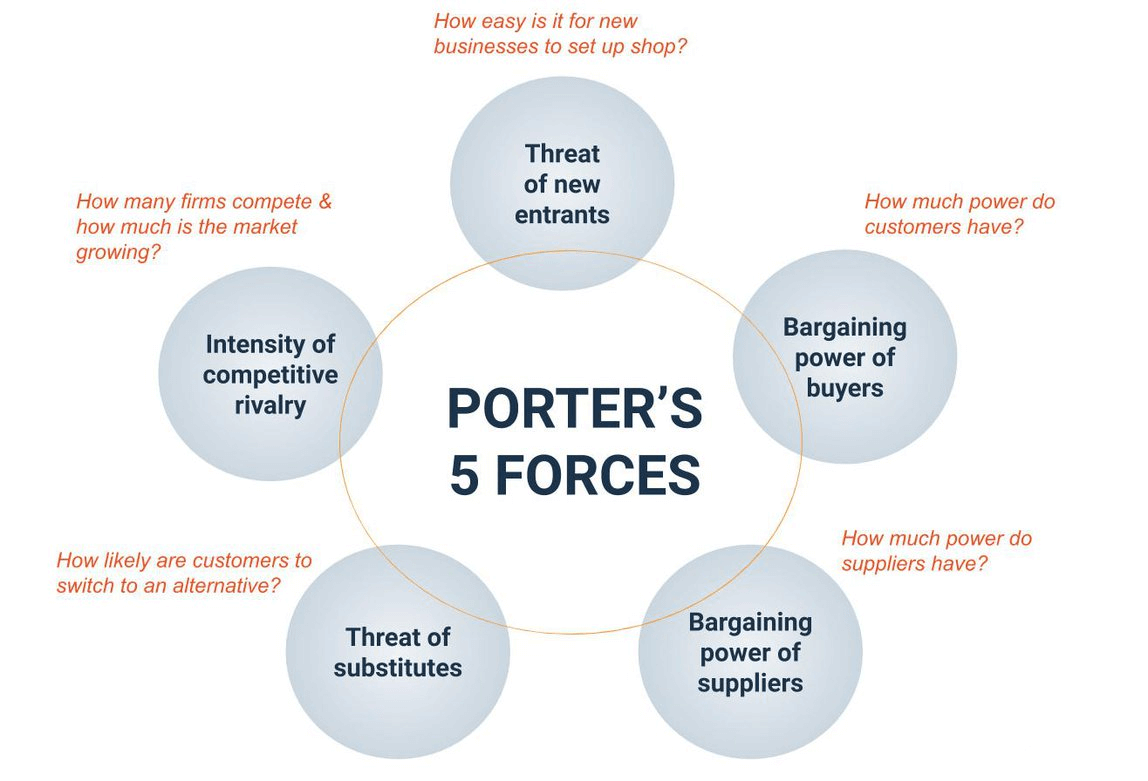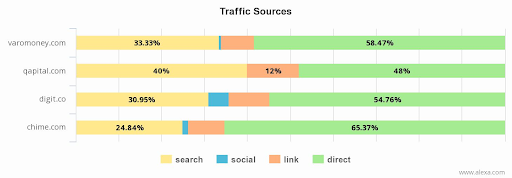Industry analysis is a critical part of understanding a company’s market position. It should tell you whether a company is faring better or worse than companies that offer similar products and services. At its core, industry analysis is designed to help you figure out how a company operates within an industry.
For marketing agencies, you can conduct several types of industry analysis based on your client’s needs; Porter’s Five Forces allows you to identify your standing among competitors through specific industry forces. The better you understand these forces, the better you determine how they can impact your client’s long-term profitability.
Every successful marketing strategy begins with a robust industry analysis and a deep dive into the competition. This is how to use Porter’s Five Forces to conduct an industry analysis.
What is Porter’s Five Forces?
Based on Michael Porter’s groundbreaking article for the Harvard Business Review, Porter’s Five Forces is a competitive analysis framework that helps you examine the competitive market forces in an industry or segment.
What’s Included in an Industry Analysis Using Porter’s 5 Forces?
The five forces Porter recognizes in its industry analysis method are:
- The intensity of competitive rivalry
- Bargaining power of suppliers
- Bargaining power of buyers
- Threat of substitutes
- The threat of new entrants
According to Porter, “the collective strength of these forces determines the ultimate profit potential of an industry.”

Porter’s Five Forces also has varied uses in practice. For example, in addition to helping you identify top competitors, you can use it to determine how to structure a marketing strategy as a company grows or the attractiveness of a new market. This industry analysis method will give you a clearer sense of your client’s competitive landscape.
1. Intensity of Competitive Rivalry
The number and strength of competitive rivals in an industry impact relationships with customers and suppliers. Industries with more competitive rivals make it difficult for a company to secure loyal customers because they have more options. Cost leadership and product differentiation can be effective strategies for alleviating your client’s risks in a highly competitive industry.
Considerations for Industry Analysis: Determine the number of competitive rivals and what they offer regarding their product or service. Survey the competitive landscape to determine your opportunity level to build successful long-term relationships with customers and suppliers.
2. Bargaining Power of Suppliers
Expensive supplies and unpredictable shifts in supplier pricing impact company profitability. Ideally, your client should position themselves in an industry with many preexisting suppliers with whom they can work. If only a few suppliers are available, it’s essential to ensure that those relationships are strong and that they see the value of working with your client.
For example, if you look at a niche industry with few suppliers, those suppliers have massive power over pricing and quality. Since few alternatives are available, a company’s primary supplier has more freedom to dictate the terms of the relationship versus an industry with many suppliers.
Considerations for Industry Analysis: Find out who the primary suppliers in your industry are, how many there are, and what kind of existing relationships they may have with competitive rivals.
3. Bargaining Power of Buyers
The size of a company’s customer base can impact its ability to influence pricing and quality. For example, this is why a large grocery store chain that has stores in most states has more freedom to offer discount pricing versus a small convenience store located in a remote area. As the only store around, a remote convenience store may also have more power to charge more for groceries.
In a highly specialized industry where a handful of buyers account for most sales, those buyers can demand more of a product or service. The more buyers a company has, the less reliant it is on that small group.
[novashare_tweet tweet=”In a highly specialized industry where a handful of buyers account for the majority of sales, those buyers can demand more of a product or service.” theme=”simple-alt” cta_text=”Click to tweet” hide_hashtags=”true”]
Considerations for Industry Analysis: Ensure you dig into how extensive a client’s customer base is, how much buyers are willing to spend, and how loyal that customer base is. If buyers are having issues with the pricing of a product or service, for example, your client will need to do everything they can to respond to buyer price sensitivity.
4. Threat of Substitutes
If several substitutes exist for a product or service on the market, buyers have more options to seek out similar products or services. Your client needs to ensure their product or service maintains demand among customers. That way, even if a substitute appears at some point, customers will trust the quality of their product or service regardless. For example, Microsoft Excel can be viewed as a substitute for project management software or different calendar apps.
When a substitute for a company’s product or service that is currently on the market appears, it can be potentially damaging. Buyers may be tempted to use an alternative if the substitute includes many similar features at a much lower price. This is why it’s so important to understand your buyers on a deeper level.
Considerations for Industry Analysis: Find out how easy it is to find a substitute for your client’s product or service. Can the product or service be emulated cheaper? How important is the quality of the product or service to buyers?
5. Threat of New Entrants
If it’s easy to access your industry, the chance of new competitive rivals entering it is high. This can lead to a crowded industry where many new competitive rivals appear regularly. Most of us can recall the 3D TV craze that saw a flood of high-profile TV makers quickly enter the scene, only for the industry almost to die out entirely just a few years later.
How easy is it for new entrants to join an industry? All a clothing company needs is access to a clothing supplier and some designs. It’s not that difficult, which is why so many clothing companies exist. On the other hand, a company specializing in building navigational software for the marine industry will have much more rigid standards that must be adhered to. This makes it far more difficult for new entrants within that industry.
Considerations for Industry Analysis: Investigate an industry’s strict laws and regulations, the primary roadblocks to entry, and outsider interest in joining.
Conducting Industry Analysis Using Porter’s Five Forces: In Practice
Now that we’ve dug into what each force means, let’s look at an example of how you can put them into practice using a real business.
Varo is an American neobank that provides a fully online alternative to traditional banking services generally offered by banks with physical branches. The following example examines how each of Porter’s Five Forces may apply to Varo and how they could collectively impact its market position.
Competitive Rivals
Varo’s competitive rivals include companies like Chime, Digit, and Qapital. Using Alexa’s Site Overview and Site Comparison tools, we see that Varo has the second-largest percentage of direct traffic to their site among competitors. Varo is also relatively evenly matched among competitors in terms of backlinks to their site.
Suppliers
Varo works with Visa in a debit provider capacity. How much Visa charges Varo to use its services can impact Varo’s profitability. That said, aligning with another well-known brand lends legitimacy. Except for Digit, each competitor mentioned above also works with Visa and uses their services. Because of this, Visa has a more significant share of power in determining how much they want to charge each company — including Varo.
Buyers
Varo’s customer base is entirely online, with no physical barriers. Any geographical borders within the United States do not limit them. Varo’s service can be accessed from anywhere within the country by anyone looking for an online banking alternative. This gives Varo a lot of power in terms of how many customer segments they can potentially attract at any point in time.
Substitutes
While Chime, Digit, and Qapital are competitors, traditional banks or credit unions offer potential substitutes for Varo’s products and services. Varo may want to analyze traditional banks’ strategies to determine whether they invest in similar products or customer segments.
New Entrants
While a growing number of businesses offer online alternatives to traditional banking solutions, several laws and regulations govern online banking services. These laws and regulations may not be a massive hurdle for finance tech companies, but getting recognized as a legitimate online banking source can be challenging for potential new entrants.
What Does All This Mean?
We can extract some essential marketing insights by collectively examining Varo using Porter’s Five Forces for our industry analysis example. Among competitors, Varo appears to have a strong presence in direct traffic. This suggests people recognize the Varo brand and are returning website visitors. Their high reach percentage also means the number of daily website visitors is generally higher than that of their competitors.
In the banking industry, where personal security is a top priority for customers, Varo’s relationship with a significant debit provider like Visa also adds legitimacy. This valuable relationship is already marketed and has good visibility on the company’s site. A fully online customer base also allows Varo to target potential customers anywhere within the United States.
This information can help inform Varo’s current marketing strategy and dictate what aspects they should focus on to continue to thrive within their industry.
Staying Ahead of the Competition
Competico offers various useful Competitive Analysis Tools to help you better understand your client’s competitive landscape and provide opportunities to help grow their marketing strategy.
Check our digital marketing competitive intelligence services.






